Art
web | ARTH Home | ARTH
Courses | ARTH 109 | ARTH 109 Assignments | Forward | Back
| Contact
Arth 109
Late Antique and Early Christian
Art
Slide List 16

|
|

|
|
Augustus of Primaporta, c. 20 B.C. or c. 14 A.D. (Principate)- cuirass statue |
Colossus of Barletta, 5th c. A.D. (Dominate) |
 Coin of the Emperor Valens, 364-7. Holding Labarum
with Cross.
Coin of the Emperor Valens, 364-7. Holding Labarum
with Cross.
|
|
|

Consular Diptych of Probus depicting the Emperor Honorius, 406 AD. Holds Labarum with inscription: In nomine XPI vincas semper (In the name of Christ you always conquer). Note halo around head of Honorius with inscription: Dn Honorios semp aug (Lord Honorius always Augustus).
|

|

|
| Arch of Constantine, c. 312-315 A.D., Rome,
commemorates Constantine's victory over Maxentius. Includes reliefs
taken from monuments of earlier emperors: Trajan, Hadrian, and
Marcus Aurelius. |
Arch of Titus, c. 81 A.D. Rome. |
| |

|
| |
Detail of the Arch of Constantine: Medallions,
Hadrianic, c. 117-138; Frieze, Constantinian, 312-315 A.D. |
| |

|
| Bronze portrait of Constantine. |
Marble portrait of Constantine, c. 330
A.D. |

|

|
| Palace Basilica of Constantine, Trier,
Germany, 305-312 A.D. |
Sta. Sabina, interior view towards the
apse, Rome early 5th c. (Nicene Creed) |

Exterior of Sta. Sabina
|
|

|

|
| Model of the Forum of Trajan, c. 113 A.D. |
Old St. Peter's, reconstruction view of
the exterior and plan, Rome, first half of the 4th c. |

|
  
|
| Santa Pudenziana, apse mosaic, c. 390 |
Missorium of the Emperor Theodosius (silver
plate), 388 A.D. |
 |

|
| Sarcophagus of Junius Bassus, 359 A.D. |
Christ from Archiepiscopal Palace in Ravenna, early fifth century. See Post-Constantinian Images of Christ. |
|
 
|
| Detail of the Augustus of Primaporta showing the cuirass. |
Detail of the Junius Bassus Sarcophagus
with Christ with Peter and Paul (Traditio legis) and the Entry
into Jerusalem (Adventus). |

Nike of Samothrace, c. 190
|

Child's Sarcophagus, late 4th c. A.D.
|
|

|
| Joshua at the Battle of Jericho, mosaic from the nave of Santa Maria Maggiore, Rome, c. 432-440. |
Melchizedek offering bread and wine to
Abraham, c. 432-440 A.D., mosaics from the nave of Santa Maria
Maggiore, Rome. |
|
|
| "Adventus" of Marcus Aurelius, c. 176 A.D. |
Trajan and Barbarian Chieftain, from the Column of Trajan, c. 106-113. |

|

|
| Interior view of the Church of San Vitale,
looking into the apse, Ravenna, c. 525-547. |
Justinian as Defender of the Faith, Barberini Diptych, Leaf of an imperial ivory plaque, mid- 6th century. |

|
|
| The Emperor and his court (Maximianus-
Bishop), San Vitale. |
Christ enthroned between angels and Saints, apse mosaic, San Vitale. |
| |
|
| |
|
MAP OF CONSTANTINIAN ROME

Terms
"Traditio legis": litterally the "translation
of the law." This refers to a conventional iconographic theme
in Roman art showing the Emperor dispensings the law. If signifies
that the Emperor is the source of law. This theme was adapted
by Christian artists with Christ dispensing the divine law.
Mosaic- a method of decorating walls, pavements, and vaults
with patterns or pictures composed of small pieces of colored
stone or glass (tesserae) set in wet cement which, upon hardening,
holds them in place. Mosaics were widely used in ancient Roman
houses and Early Christian and Byzantine Churches.
Quotation
From St. John Chrysostom's commentary on Matthew I:
You will see the king, seated on the throne of that unutterable
glory, together with the angels and archangels standing beside
him, as well as the countless legions of the ranks of the saints.
This is how the Holy City appears.... In this city is towering
the wonderful and glorious sign of victory, the cross, the victory
booty of Christ, the first fruit of our human kind, the spoils
of war of our king.
Links
I have developed webpages for topics included in this slide
list for my Medieval Art class. You are encouraged to review them:
Late Antiquity:
the Imperial Image, the Early
Christian Basilica, the Post-Constantinian
Conception of Christ, and the Mosaics
of the Church of San Vitale. See also the webpage entitled "The Christianization of Rome and the Romanization of Christianity."
Questions for Review
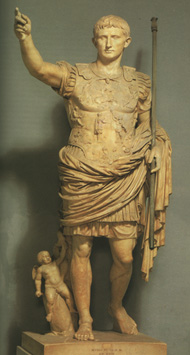
|
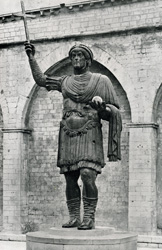
|
| Augustus of Primaporta,c. 20 B.C. or c.14
A.D.- Principate. |
Colossus of Barletta, 5th c. A.D. |
Through an analysis of the styles of these two works demonstrate
how the artists have created effective images of the authority
of the Emperor for their respective periods.
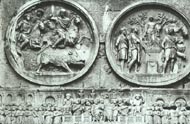
|
| Hadrianic Medallion, c. 117-138 A.D. and
Constantinian frieze, c. 312-315 from the Arch of Constantine. |
Discuss the transformation in the imperial image documented
by this comparison, and indicate some reasons for this change
in approach.

|
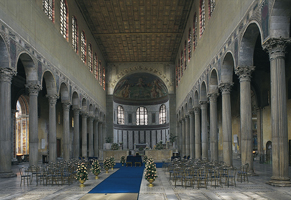
|
| Palace Basilica of Constantine, Trier,
305-312 A.D. |
Church of Santa Sabina, early 5th century A.D. |
Discuss the sources of Christian architecture illustrated by
this comparison. Why would Christian architects have borrowed
these traditional architectural forms?

|
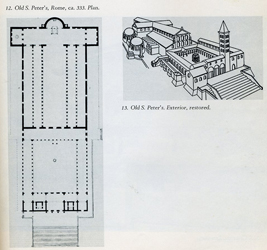
|
| Forum of Trajan, c. 113 A.D. |
Old St. Peter's, reconstruction view of
the exterior and plan, Rome, first half of the 4th c. |
Discuss the sources of Christian architecture illustrated by
this comparison. Why would Christian architects have borrowed
these traditional architectural forms?

|

|
| Santa Pudenziana, apse mosaic, c. 390 A.D. |
Missorium of the Emperor Theodosius (silver
plate), 388 A.D. |
Discuss the sources for Christian iconography documented by
this comparison.
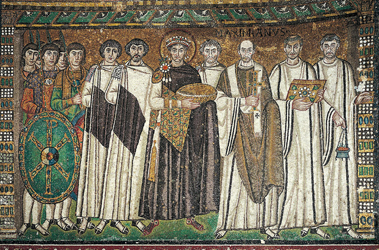
|
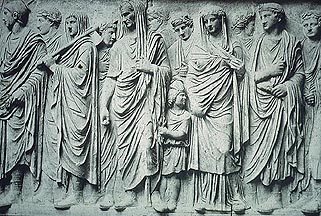
|
| Emperor Justinian and his court, San Vitale,
Ravenna, c. 525-547 A.D. |
Imperial Procession from the Ara Pacis,
13-9 B.C., |
Both of these works illustrate an Emperor participating in
a religious procession. Through an analysis of these works, demonstrate
how each presents an effective image of the authority of the Emperor
for their respective periods. Your discussion should focus on
an examination of the style and subject matter of both works.
Make sure that you observe significant similarities.
Parts
of an Early Christian Basilica
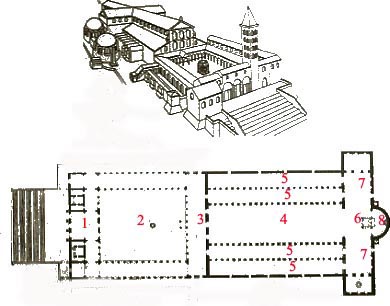
1) Propylaeum- the entrance building of a sacred precinct,
whether church or imperial palace.
2) Atrium- in early Christian, Byzantine, and medieval architecture,
the forecourt of a church; as a rule enveloped by four colonnaded
porticoes.
3) Narthex- the entrance hall or porch proceding the nave of
a church.
4) Nave- the great central space in a church. In longitudinal
churches, it extends from the entrance to the apse (or only to
the crossing if the church has one) and is usually flanked by
side aisles.
5) Side Aisle- one of the corridors running parallel to the
nave of a church and separated from it by an arcade or colonnade.
6) Crossing- the area in a church where the transept and the
nave intersect.
7) Transept- in a cruciform church, the whole arm set at right
angles to the nave. Note that the transept appears infrequently
in Early Christian churches. Old St. Peter's is one of the few
example of a basilica with a transept from this period. The transept
would not become a standard component of the Christian church
until the Carolingian period.
8) Apse- a recess, sometimes rectangular but usually semicircular,
in the wall at the end of a Roman basilica or Christian church.
The apse in the Roman basilica frequently contained an image of
the Emperor and was where the magistrate dispensed laws. In the
Early Christian basilica, the apses contained the "cathedra"
or throne of the bishop and the altar.
9) Nave elevation- term which refers to the division of the
nave wall into various levels. In the Early Christian basilica
the nave elevation usually is composed of a nave colonnade or
arcade and clerestory.
10) Clerestory- a clear story, i.e. a row of windows in the
upper part of a wall. In churches, the clerestory windows above
the roofs of the side aisles permit direct illumination of the
nave.
Art
web | ARTH
Home | ARTH Courses | ARTH 109 | ARTH
109 Assignments | Forward |
Back | Contact





































